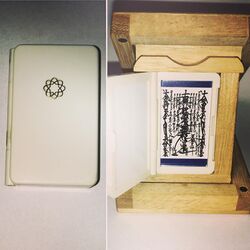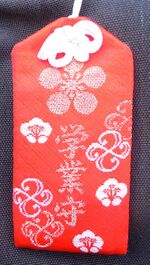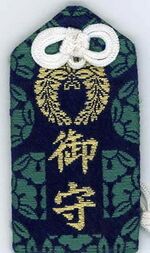Religion:Omamori
Omamori (御守/お守り) are Japanese amulets commonly sold at Shinto shrines and Buddhist temples, dedicated to particular Shinto Script error: The function "transl" does not exist. as well as Buddhist figures, and are said to provide various forms of luck and protection.
Origin and usage
The word mamori (守り) means 'protection', with Script error: The function "transl" does not exist. being the Script error: The function "transl" does not exist. (honorific) form of the word. Originally made from paper or wood, modern amulets are small items usually kept inside a brocade bag and may contain a prayer, religious inscription of invocation.[1] Script error: The function "transl" does not exist. are available at both Shinto shrines and Buddhist temples with few exceptions and are available for sale, regardless of one's religious affiliation.
Script error: The function "transl" does not exist. are then made sacred through the use of ritual, and are said to contain Script error: The function "transl" does not exist. (spiritual offshoots) in a Shinto context or Script error: The function "transl" does not exist. (manifestations) in a Buddhist context.[1]
Design and function

Script error: The function "transl" does not exist. are usually covered with brocaded silk and enclose paper or pieces of wood with prayers written on them, which are supposed to bring good luck to the bearer on particular occasions, tasks, or ordeals. Script error: The function "transl" does not exist. are also used to ward off bad luck and are often spotted on bags, hung on cellphone straps, in cars, etc.
Script error: The function "transl" does not exist. have changed over the years from being made mostly of paper and/or wood to being made out of a wide variety of materials (i.e. bumper decals, bicycle reflectors, credit cards, etc.).[3] Modern commercialism has also taken over a small part of the production of Script error: The function "transl" does not exist.. Usually this happens when more popular shrines and temples cannot keep up with the high demand for certain charms. They then turn to factories to manufacture the Script error: The function "transl" does not exist.. However, priests have been known to complain about the quality and authenticity of the products made by factories.[3]
According to Yanagita Kunio (1969):
Japanese have probably always believed in amulets of one kind or another, but the modern printed charms now given out by shrines and temples first became popular in the Tokugawa period or later, and the practice of a person wearing miniature charms is also new. The latter custom is particularly common in cities.[4]
Usage
Script error: The function "transl" does not exist. may provide general blessings and protection, or may have a specific focus such as:[5]
- Script error: The function "transl" does not exist.: traffic safety-protection for drivers and travelers of all sorts
- Script error: The function "transl" does not exist.: avoidance of evil
- Script error: The function "transl" does not exist.: open luck, better fortune
- Script error: The function "transl" does not exist.: education and passing examinations—for students and scholars
- Script error: The function "transl" does not exist.: prosperity in business—success in business and matters of money
- Script error: The function "transl" does not exist.: acquisition of a mate and marriage—available for singles and couples to ensure love and marriage
- Script error: The function "transl" does not exist.: protection for pregnant women for a healthy pregnancy and easy delivery
- Script error: The function "transl" does not exist.: safety (well-being) of one's family, peace and prosperity in the household
Customarily, Script error: The function "transl" does not exist. are not opened in order to avoid losing their protective benefits. They are instead carried on one's person, or tied to something like a backpack or a purse. It is not necessary, but amulets are customarily replaced once a year to ward off bad luck from the previous year. Old amulets are usually returned to the same shrine or temple they were purchased at so they can be disposed of properly. Amulets are commonly returned on or slightly after the Japanese New Year so the visitor has a fresh start for the New Year with a new Script error: The function "transl" does not exist..
Old Script error: The function "transl" does not exist. traditionally should not be disposed of, but burned, as a sign of respect to the deity that assisted the person throughout the year.[6]
If a shrine or temple visitor cannot find an Script error: The function "transl" does not exist. that meets their need, they can request for a priest to have one made. If enough people request for this same type of Script error: The function "transl" does not exist., the temple or shrine may start producing them for everyday availability.
Modern commercial uses
There are modern commercial versions of Script error: The function "transl" does not exist. that are typically not spiritual in nature and are not issued by a shrine or temple. It has become popular for stores in Japan to feature generic Script error: The function "transl" does not exist. with popular characters such as Mickey Mouse, Hello Kitty, Snoopy, Kewpie, etc.
See also
References
- ↑ 1.0 1.1 Reader, Ian; Tanabe, George J. (1998). Practically Religious: Worldly Benefits and the Common Religion of Japan. Honolulu: University of Hawai'i Press. p. 46. ISBN 0824820908.
- ↑ General Stone Tiger (2010-06-15). "Using the Omamori Gohonzon". Soka Gakkai International. http://www.sginz.org/assets/documents/Using-the-Omamori-Gohonzon.pdf.
- ↑ 3.0 3.1 Swanger, Eugene R.; Takayama, K. Peter (1 January 1981). "A Preliminary Examination of the "Omamori" Phenomenon". Asian Folklore Studies 40 (2): 237–252. doi:10.2307/1177866.
- ↑ Kunio, Yanagita (1969). Japanese Culture in the Meiji Era Tokyo (Vol. 4). pp. 314–315.
- ↑ Jacobsen, Natalie (2015-05-13). "Japanese Lucky Charms: The Guide to Omamori". http://www.tokyoweekender.com/2015/05/japanese-lucky-charms-the-guide-to-omamori/.
- ↑ "Guide To Japanese Lucky Charms Omamori For The New Year 2021 - Japan Truly" (in en-US). 2021-02-19. https://japantruly.com/japanese-lucky-charms-omamori-for-new-year/.
Further reading
- Masuda, Koh (1998). Kenkyusha's New Japanese-English Dictionary (4th ed.). Tokyo: Kenkyusha. ISBN 4767420156.
- Nelson, Andrew N. (1999). Japanese-English Character Dictionary (1st ed.). Rutland, Vermont: Charles E. Tuttle. ISBN 4805305746.
External links
 |



